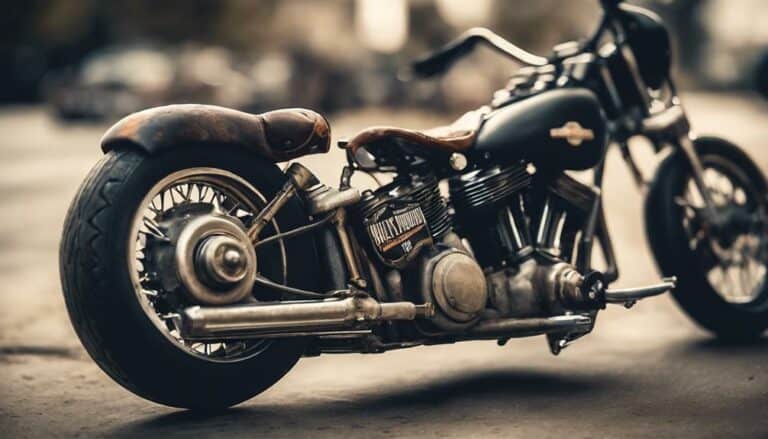Imagine the roar of a Harley Davidson Evo engine as you cruise down the open road, feeling its power beneath you. But then, suddenly, the shift to a new era leaves riders and enthusiasts wondering: Why did Harley Davidson choose to part ways with the iconic Evo motors?
The decision was influenced by a complex interplay of factors that reshaped the motorcycle landscape. Explore the intricacies behind this pivotal move and uncover the motivations that drove Harley Davidson towards a new direction in engine design.
Key Takeaways
- Evo motors were replaced to comply with stricter EPA emissions regulations.
- Transition aimed to develop cleaner, fuel-efficient engines.
- Market demands and competition influenced the technology shift.
- Challenges in patenting Evo components also played a role in the transition.
Evolution of the Harley-Davidson Evo Motor
The evolution of the Harley-Davidson Evo Motor revolutionized the company's approach to engine technology, setting the stage for advancements that would shape the future of their motorcycles.
As Harley-Davidson faced increasing emissions regulations, the shift from Evo motors to more advanced Twin Cam engines became necessary. The Evolution engine marked a significant leap forward in innovation and performance for Harley-Davidson, pushing boundaries and setting new standards in the industry.
Competitors like S&S also recognized the potential in this evolution and began producing similar engines, prompting Harley-Davidson to continually improve and develop new engine designs to stay ahead.
Furthermore, changes in ownership and market demands played a crucial role in the decision to move beyond the Evo engine technology, as the company strived to meet the evolving needs of riders and comply with stringent environmental standards. The legacy of the Evo motors lives on in the spirit of progression and adaptation that defines Harley-Davidson's commitment to excellence.
Impact of EPA Regulations on Evo Motors
Amidst the ongoing evolution of the Harley-Davidson Evo Motor, the impact of EPA regulations on emissions standards played a pivotal role in shaping the direction of engine technology for the company.
The stringent EPA regulations and the need to comply with stricter emission requirements led to the discontinuation of Evo motors in Harley-Davidson motorcycles. The company's decision to transition to newer engine designs was heavily influenced by the necessity to meet environmental regulations.
Harley-Davidson recognized that updating their engine technology was essential to ensure compliance with EPA guidelines and to develop cleaner and more fuel-efficient engines. Therefore, the shift away from Evo motors wasn't only a strategic move but also a response to the changing landscape of environmental regulations.
This transition marked a significant moment in Harley-Davidson's engine development strategy, highlighting the importance of aligning with modern emission standards to meet both regulatory requirements and consumer expectations.
Performance Issues With Evo Engines
Experiencing common issues such as oil leaks and overheating, Evo engines faced performance challenges that prompted Harley-Davidson to seek improvements through new engine technologies. The performance issues with Evo engines included:
- Oil Leaks and Gasket Failures: Some Evo engines were prone to oil leaks caused by gasket failures, leading to potential maintenance headaches for riders.
- Overheating Problems: Certain Evo engine models encountered overheating problems, which could affect performance and reliability during long rides.
- Camshaft and Lifter Wear: Evo engines were known for occasional camshaft and lifter wear concerns, impacting the longevity of these components and potentially leading to performance degradation.
To mitigate these shortcomings, S&S Cycle offered upgrades to address the issues with Evo engines. Additionally, Harley-Davidson introduced the Twin Cam engine as a successor, aiming to enhance performance and reliability in their motorcycles, marking a significant transition in their engine lineup.
Transition to Twin Cam Engines
Given the performance challenges faced by Evo engines, Harley-Davidson's shift to Twin Cam engines marked a significant advancement in addressing these issues and meeting evolving industry standards. The transition to Twin Cam engines was primarily driven by the need to keep up with the increasing performance demands and competition in the motorcycle market. Harley-Davidson aimed to enhance performance and incorporate technological advancements through the Twin Cam design. Challenges related to patenting the Evo components, like the single pin crank, also influenced this shift.
Moreover, changes in ownership, including AMF selling the company, likely played a role in the decision to move away from Evolution engines. The transition from Evo to Twin Cam engines not only aligned with emissions regulations but also catered to market preferences for improved performance. This strategic move showcased Harley-Davidson's commitment to adapting to evolving standards and staying competitive in the ever-changing motorcycle industry.
Legacy of the Harley-Davidson Evo Motors
Although discontinued, the legacy of Harley-Davidson's Evo motors endures as a testament to their reliability, distinctive exhaust note, and enduring popularity among enthusiasts.
- Reliability and Durability: Evo motors were renowned for their robust construction, contributing to Harley-Davidson's resurgence in the 1980s. The incorporation of aluminum components not only enhanced cooling but also reduced maintenance costs, making them a favorite among riders seeking longevity.
- Distinctive Exhaust Note: One of the most cherished aspects of Evo motors is their unique sound, which resonates with authenticity and power. Enthusiasts appreciate the unmistakable rumble that these engines produce, adding to the overall riding experience.
- Performance Characteristics: Evo motors were celebrated for their performance capabilities, delivering a blend of power and responsiveness that defined a generation of Harley-Davidson motorcycles. Despite evolving emission regulations and shifting market demands prompting their retirement, the Evo motors remain a beloved chapter in the brand's history.
Conclusion
As you reflect on Harley Davidson's decision to phase out the Evo motors, consider the complex factors at play. From regulatory challenges to shifting market demands, the transition to Twin Cam engines was a strategic move to stay competitive.
While the Evo motors may no longer be in production, their legacy lives on through their reliability, performance, and unique characteristics that continue to be cherished by motorcycle enthusiasts.
Remember, change is inevitable in the ever-evolving landscape of the motorcycle industry.

